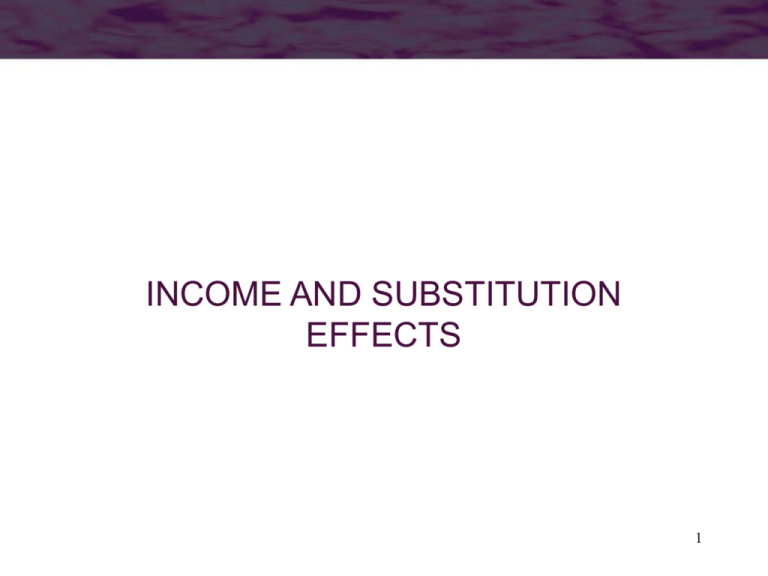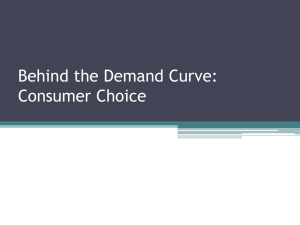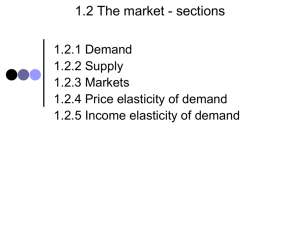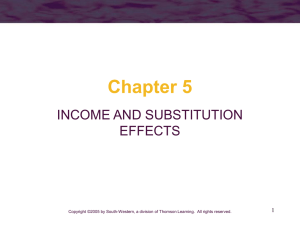Income-Sustitution Effects
advertisement

INCOME AND SUBSTITUTION EFFECTS 1 Demand Functions • The optimal levels of x1,x2,…,xn can be expressed as functions of all prices and income • These can be expressed as n demand functions of the form: x1* = d1(p1,p2,…,pn,I) x2* = d2(p1,p2,…,pn,I) • • • xn* = dn(p1,p2,…,pn,I) 2 Demand Functions • If there are only two goods (x and y), we can simplify the notation x* = x(px,py,I) y* = y(px,py,I) • Prices and income are exogenous – the individual has no control over these parameters 3 Changes in Income • An increase in income will cause the budget constraint out in a parallel fashion • Since px/py does not change, the MRS will stay constant as the worker moves to higher levels of satisfaction 4 Increase in Income • If both x and y increase as income rises, x and y are normal goods Quantity of y As income rises, the individual chooses to consume more x and y B C A U3 U1 U2 Quantity of x 5 Increase in Income • If x decreases as income rises, x is an inferior good As income rises, the individual chooses to consume less x and more y Quantity of y Note that the indifference curves do not have to be “oddly” shaped. The assumption of a diminishing MRS is obeyed. C B U3 U2 A U1 Quantity of x 6 Normal and Inferior Goods • A good xi for which xi/I 0 over some range of income is a normal good in that range • A good xi for which xi/I < 0 over some range of income is an inferior good in that range 7 Changes in a Good’s Price • A change in the price of a good alters the slope of the budget constraint – it also changes the MRS at the consumer’s utility-maximizing choices • When the price changes, two effects come into play – substitution effect – income effect 8 Changes in a Good’s Price • Even if the individual remained on the same indifference curve when the price changes, his optimal choice will change because the MRS must equal the new price ratio – the substitution effect • The price change alters the individual’s “real” income and therefore he must move to a new indifference curve – the income effect 9 Changes in a Good’s Price Suppose the consumer is maximizing utility at point A. Quantity of y If the price of good x falls, the consumer will maximize utility at point B. B A U2 U1 Quantity of x Total increase in x 10 Changes in a Good’s Price Quantity of y To isolate the substitution effect, we hold “real” income constant but allow the relative price of good x to change The substitution effect is the movement from point A to point C A C U1 The individual substitutes good x for good y because it is now relatively cheaper Quantity of x Substitution effect 11 Changes in a Good’s Price Quantity of y The income effect occurs because the individual’s “real” income changes when the price of good x changes B A The income effect is the movement from point C to point B C U2 U1 If x is a normal good, the individual will buy more because “real” income increased Quantity of x Income effect 12 Changes in a Good’s Price Quantity of y An increase in the price of good x means that the budget constraint gets steeper The substitution effect is the movement from point A to point C C A B U1 The income effect is the movement from point C to point B U2 Quantity of x Substitution effect Income effect 13 Price Changes for Normal Goods • If a good is normal, substitution and income effects reinforce one another – when price falls, both effects lead to a rise in quantity demanded – when price rises, both effects lead to a drop in quantity demanded 14 Price Changes for Inferior Goods • If a good is inferior, substitution and income effects move in opposite directions • The combined effect is indeterminate – when price rises, the substitution effect leads to a drop in quantity demanded, but the income effect is opposite – when price falls, the substitution effect leads to a rise in quantity demanded, but the income effect is opposite 15 Giffen’s Paradox • If the income effect of a price change is strong enough, there could be a positive relationship between price and quantity demanded – an increase in price leads to a drop in real income – since the good is inferior, a drop in income causes quantity demanded to rise 16 The Individual’s Demand Curve • An individual’s demand for x depends on preferences, all prices, and income: x* = x(px,py,I) • An individual demand curve shows the relationship between the price of a good and the quantity of that good purchased by an individual assuming that all other determinants of demand are held constant 17 The Individual’s Demand Curve Quantity of y As the price of x falls... px …quantity of x demanded rises. px’ px’’ px’’’ U1 x1 I = px’ + py x2 x3 I = px’’ + py U2 U3 Quantity of x I = px’’’ + py x x’ x’’ x’’’ Quantity of x 18 Shifts in the Demand Curve • A movement along a given demand curve is caused by a change in the price of the good – a change in quantity demanded • A shift in the demand curve is caused by changes in income, prices of other goods, or preferences – a change in demand 19 Demand • The Cobb-Douglas utility function is U(x,y) = xy (+=1) • The demand functions for x and y are I x px I y py 20 Demand Functions and Curves 0 .3 I x* px 0.7I y* py • If the individual’s income is $100, these functions become • Any change in income will shift these demand curves 30 x* px 70 y* py 21 Uncompensated Demand Curves • The actual level of utility varies along the demand curve • As the price of x falls, the individual moves to higher indifference curves – it is assumed that nominal income is held constant as the demand curve is derived – this means that “real” income rises as the price of x falls • know as an uncompensated or Marshallian Demand 22 Compensated Demand Curves • An alternative approach holds real income (or utility) constant while examining reactions to changes in px – the effects of the price change are “compensated” so as to constrain the individual to remain on the same indifference curve – reactions to price changes include only substitution effects • Also know as Hicksian Demand 23 Compensated Demand Curves • A compensated (Hicksian) demand curve shows the relationship between the price of a good and the quantity purchased assuming that other prices and utility are held constant • The compensated demand curve is a twodimensional representation of the compensated demand function x* = xc(px,py,U) 24 Compensated Demand Curves Holding utility constant, as price falls... Quantity of y px p ' slope x py slope …quantity demanded rises. px ' ' py px’ px’’ slope px ' ' ' py px’’’ xc U2 x’ x’’ x’’’ Quantity of x x’ x’’ x’’’ Quantity of x 25 Compensated & Uncompensated Demand px At px’’, the curves intersect because the individual’s income is just sufficient to attain utility level U2 px’’ x xc x’’ Quantity of x 26 A Mathematical Examination of a Change in Price xc (px,py,U) = x[px,py,E(px,py,U)] • We can differentiate the compensated demand function and get x c x x E px px E px x x c x E px px E px 27 The Slutsky Equation • The substitution effect can be written as x c x substituti on effect px px U constant • The income effect can be written as x E x E income effect E px I px • Note that E/px = x – a $1 increase in px raises necessary expenditures by x dollars 28 The Slutsky Equation • The utility-maximization hypothesis shows that the substitution and income effects arising from a price change can be represented by x substituti on effect income effect px x x px px U constant x x I 29 Marshallian Demand Elasticities • Most of the commonly used demand elasticities are derived from the Marshallian demand function x(px,py,I) • Price elasticity of demand (ex,px) ex ,p x x / x x px px / px px x 30 Elasticities • Income elasticity of demand (ex,I) e x ,I x / x x I I / I I x • Cross-price elasticity of demand (ex,py) ex , py x / x x py py / py py x 31 Price Elasticity of Demand • The own price elasticity of demand is always negative – the only exception is Giffen’s paradox • The size of the elasticity is important – if ex,px < -1, demand is elastic – if ex,px > -1, demand is inelastic – if ex,px = -1, demand is unit elastic 32 Homogeneity • Demand functions are homogeneous of degree zero in all prices and income • Euler’s theorem for homogenous functions shows that x x x 0 px py I px py I 33 Homogeneity • Dividing by x, we get 0 ex,px ex,py ex,I • Any proportional change in all prices and income will leave the quantity of x demanded unchanged 34 Engel Aggregation • We can see this by differentiating the budget constraint with respect to income (treating prices as constant) x y 1 px py I I x xI y yI 1 p x py s x e x , I s y ey , I I xI I yI 35 Engel Aggregation • Engel’s law suggests that the income elasticity of demand for food items is less than one – this implies that the income elasticity of demand for all nonfood items must be greater than one 36









